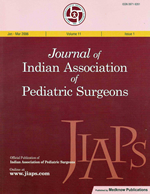
|
Journal of Indian Association of Pediatric Surgeons
Medknow Publications on behalf of the Indian Association of Pediatric Surgeons
ISSN: 0971-9261
EISSN: 0971-9261
Vol. 11, No. 1, 2006, pp. 41-43
|
 Bioline Code: ip06010
Bioline Code: ip06010
Full paper language: English
Document type: Research Article
Document available free of charge
|
|
|
Journal of Indian Association of Pediatric Surgeons, Vol. 11, No. 1, 2006, pp. 41-43
| en |
Case Report - C S F pseudocysts peritoneal cavity following V P shunt surgery: Report of three cases in children and review of literature
Ghritlaharey RajendraK, Budhwani KS, Shrivastava DK, Jain AJ, Gupta G, Kushwaha AS
Abstract
Abdominal cerebrospinal fluid (CSF) pseudocyst is an uncommon complication following ventriculo-peritoneal (VP) shunt. The following report′s our experience with three cases of CSF pseudocyst in children. VP shunt was done earlier for communicating hydrocephalus following tubercular meningitis (TBM) in all cases. Clinical presentation was with progressive abdominal distension and features of intestinal obstruction. Clinically we were able to diagnose all cases as CSF pseudocyst peritoneal cavity. Ultrasound examination confirmed the clinical findings in all. CT scan of abdomen and pelvis showed a large unilocular CSF pseudocyst with shunt catheter within it on one patient (case 3). Ultrasound guided aspiration of cyst was done in case 1 alone, but failed to resolve the symptoms. All patients needed formal exploration. Near total cyst excision, adhesiolysis and relocation of peritoneal end of VP shunt catheter in right supra hepatic space was done in all. Two patients who developed shunt tract infection needed shunt removal. The follow up period is 6-8 months.
Keywords
CSF pseudocyst peritoneal cavity, V P shunt complication
|
| |
© Copyright 2006 Journal of Indian Association of Pediatric Surgeons.
Alternative site location: http://www.jiaps.com/
|
|
